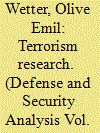| Srl | Item |
| 1 |
ID:
131359


|
|
|
|
|
| Publication |
2014.
|
| Summary/Abstract |
In terrorism research, three different sources of information and data exist: the terrorists and their environment; the incidents; and the population. This article discusses the strengths and weaknesses of research that is concerned with, or relies on, any of the mentioned sources. An in-depth understanding of the methodological issues that come with these sources is important to correctly interpret results from scientific studies. It is highlighted how the different scientific approaches add to a holistic view of terrorism as a phenomenon. Furthermore, the double-edged sword of information in the field of terrorism is discussed. From these deliberations, guidance concerning the future work of both scholars and decision-makers can be deducted.
|
|
|
|
|
|
|
|
|
|
|
|
|
|
|
|
| 2 |
ID:
140556


|
|
|
|
|
| Summary/Abstract |
Up to the present, there is only very little research on how the population perceives terrorism and its threats, even though support from the population is crucial for effective counterterrorism. By eliciting beliefs and subjecting them to content analyses, six factors were found that determine the protection worthiness of a target in the people's view: the potential damage to “people,” “symbolism,” “economy,” “politics,” “nature,” and “image/publicity.” These empirically found factors are in line with factors specified by terrorist target selection models. They differ in the strength of their cognitive representation among participants and, thus, their subjective importance to the people. The first three factors are shared among all participants, whereas the latter ones could only be found in a part of the participant sample. People's judgments of the targets' protection worthiness differ substantially from their judgments of the targets' attractiveness to terrorists, even though the same factors seem to be involved. This study offers an insight into the people's mental model about protection worthiness of targets. Together with classical risk analysis and knowledge about terrorists, these results can form a basis for setting up a holistic scheme for critical infrastructure protection.
|
|
|
|
|
|
|
|
|
|
|
|
|
|
|
|